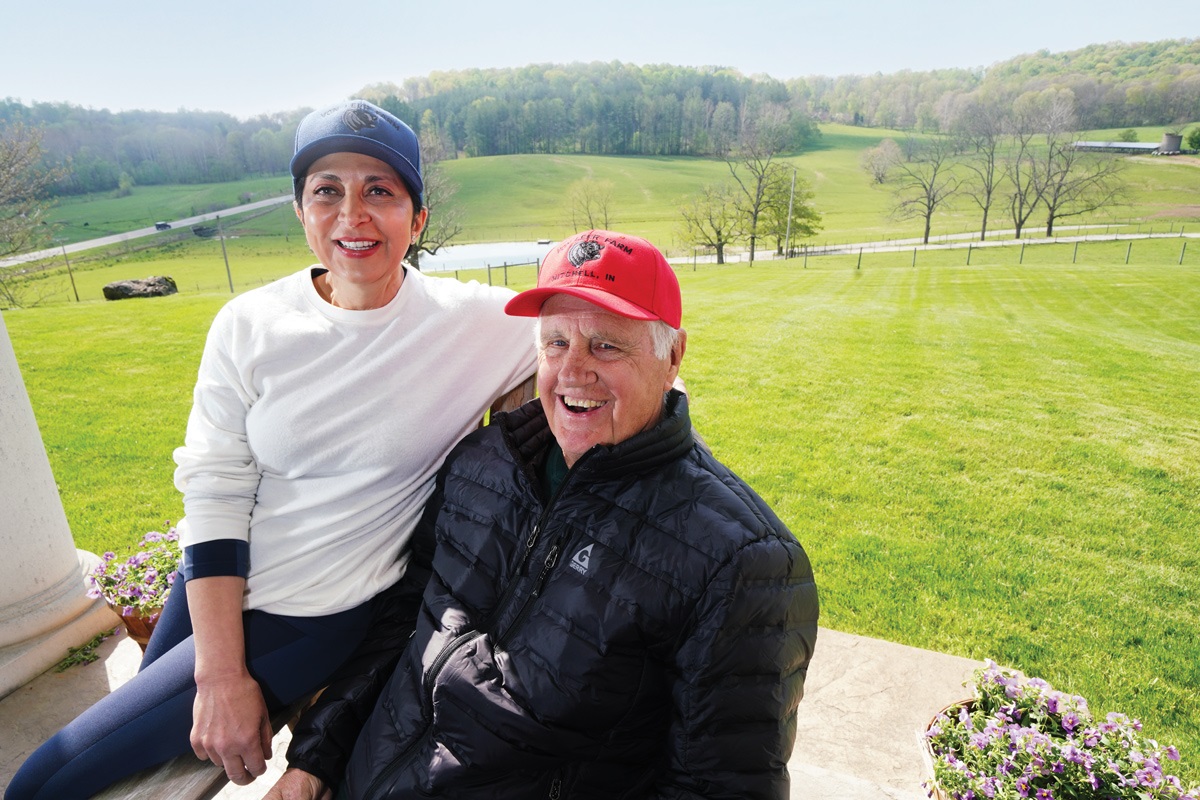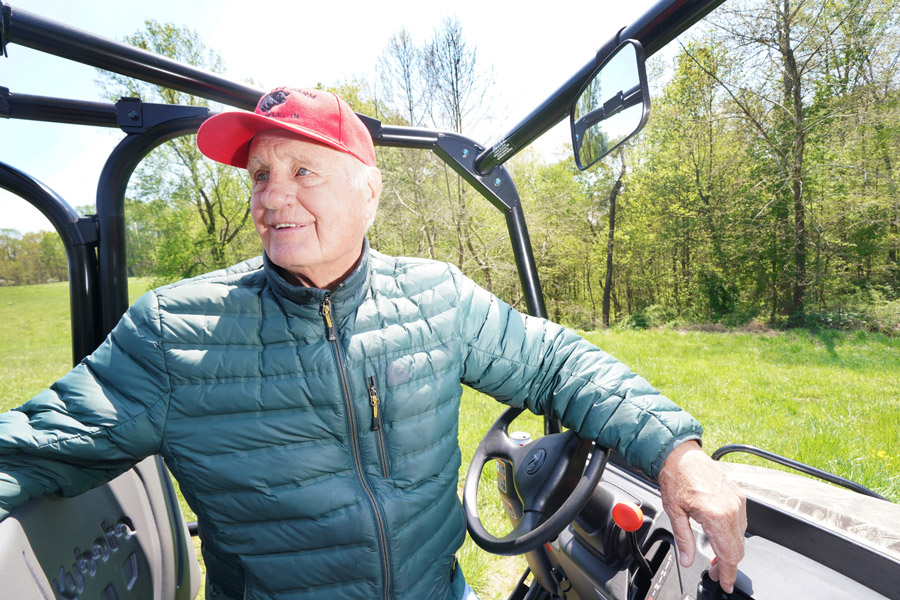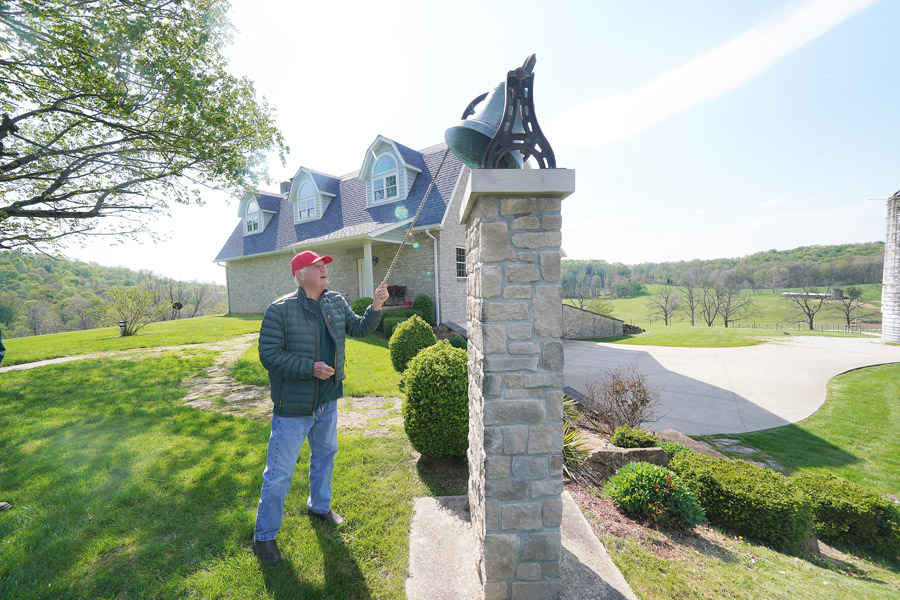legacy
SHARING
THE GIFT OF
KNOWLEDGE
BY STACEY MICKELBART

SHARING
THE GIFT OF
KNOWLEDGE
BY STACEY MICKELBART

It’s 1986, and the scene opens with J.R. Ewing, the charming but scheming oil tycoon of the television saga “Dallas,” played by Larry Hagman, being chauffeured by jeep through pasture and forest. He’s meeting the elusive B.D. Calhoun, a muscular, blond, square-jawed mercenary — aka actor Hunter von Leer. Ewing wants Calhoun to blow up some oil rigs, but it’s a meeting he’ll come to regret when their plot unravels and the ruthless Calhoun menaces his family.
Fast forward to a new scene in 2023. Now von Leer looks out over his own 650 acres of pasture and hardwood forest in Mitchell, Indiana, sharing tales of Hollywood friends (like Hagman) and his acting roles, ranging from “General Hospital,” “The Rockford Files” and “Magnum P.I.” to movies like “Halloween II” and “History of the World, Part I.” He also shares the story of his farm, and why he and his wife, Fariba Zand, are bequeathing it to Purdue University.
Von Leer grew up near Terre Haute, Indiana, and earned his degree from Indiana State University before taking a teaching position in California. He quickly parlayed his love for adventure into work as a stuntman and actor. But he stayed in touch with his Indiana roots and jumped at the chance to buy a farm in Lawrence County in the 1980s.
“I didn’t know anything about anything down here,” von Leer says. “Except I always loved this county because as a kid, I got my name drawn to hunt at Crane naval depot. I didn’t know that Indiana had rolling hills. It reminded me of ‘The Adventures of Huckleberry Finn.’”
He owned a saddle by Ed Bohlin, “Saddlemaker to the Stars” like Roy Rogers, so he sold the collectible to pay for his portion of the farm, later buying out his partner. He had a lot to learn about building up his Angus herd and managing the forest he’d acquired.
“I didn’t know the difference between a heifer and a Hereford,” von Leer quips. “I knew they both started with ‘h,’ but I got them confused all the time.”
He called Richard Huntrods, then director of the Feldun Purdue Agricultural Center (FPAC) about 20 miles away, and asked for advice about buying bulls from the Indiana Beef Evaluation Program Test Station at FPAC. “Purdue was so polite and nice,” von Leer says.
That was the beginning of a relationship that continues with the Feldun staff today, following his friend Huntrods’ retirement. “The guys are great any time we need help,” says Zand, who often spends time at the farm while maintaining her career as an insurance agent in California.
She and von Leer camped in a barn, sleeping under a tarp on hay, as they built a gracious hilltop farmhouse on the site of the original homestead, which had burned down.
Dogwood and hackberry grace the edge of a pond in the hardwood forest of von Leer Farm.
Now she and von Leer love to explore and hunt on the property. “I could get lost in these woods, just wandering for two to three hours,” Zand says. They’ve selectively harvested hickory, oak, walnut and maple for the finishes and furnishings in their home, including the kitchen’s 10-and-a-half-foot oak trestle table. They’ve also developed springs and ponds across the property and worked to prevent erosion and manage invasive species.
Von Leer drew on the FPAC team’s expertise in bull selection, pasture rotation and fertilization, forages and weed control to develop his own award-winning herd. “The fact that my calves do so well overall, and my bulls do well — they’ve obviously taught me a lot. How do you put a scale on it?” he asks. “It’s not one little thing that they teach you, it’s the whole package, if you’re willing to listen.”
This assistance, and the wish to avoid division of their land, helped solidify the couple’s decision to will it to Purdue. They hope it will be useful for the research and education of faculty and students in animal sciences and forestry and natural resources.
“It’s a decision that we’ve never wavered with and never questioned,” von Leer says. Zand agrees.
While his work as a farmer and land manager might seem the opposite of life as a Hollywood actor, von Leer’s curiosity, willingness to learn and persistence in doing things well have made him successful in both roles. That’s reflected in his advice to students.
“If you had the choice between being the best actor in your class and zero hustle, or being a good actor with a 100 percent hustle? Go with the 100 percent hustle,” he says. “You’ll make it. You will never make it being a great actor in front of your class. You have to get out there.”



